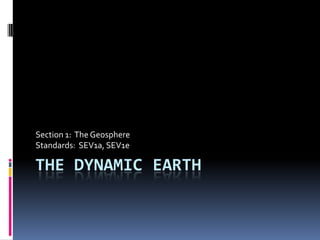
The Dynamic Earth: A Look at the Geosphere
- 1. Section 1: The Geosphere Standards: SEV1a, SEV1e THE DYNAMIC EARTH
- 2. Why is the Earth classified as a “system”? A system consists of parts that work together. Parts of the Earth: Geosphere/lithosphere Atmosphere Hydrosphere Biosphere
- 3. What makes up the Geosphere? All the rocks and soil on Earth’s surface. Scientists divide the geosphere into COMPOSITIONAL layers PHYSICAL layers. 1 kilometer= 0.62 mile or 10 football fields.
- 4. What are the COMPOSITIONAL layers of the Geosphere? Density, temperature & pressure increase as you go towards center. Crust Thin, outer layer (5-70 km thick) Lightweight elements Less than 1% of Earth’s mass Thicker beneath continents and thinner under ocean. Mantle Thicker middle layer (2,900 km thick) Dense, iron-rich material Core Inner sphere (3,400 km radius) Sphere of hot, dense nickel and iron
- 5. What are the PHYSICAL layers of the Geosphere? Lithosphere Crust and uppermost mantle Consists of tectonic plates Asthenosphere Mantle rock that moves slowly. Solid yet plastic Allows tectonic plates to move Mesosphere Lowest part of mantle Outer core Liquid nickel and iron Inner core Solid nickel and iron 4,000-5,000ºC Enormous pressure
- 6. How are the layers of Earth determined? Scientists use seismic waves to “see” and learn about Earth’s interior. Seismic waves react differently when they hit or pass thru a material.
- 7. Plate tectonics Tectonic plates glide on asthenosphere Major plates: Pacific, N. American, S. American, African, Eurasian, Antarctic Geologic activity occurs along plate boundaries Divergent- pull apart- get volcano or ridge EX: Mid-Atlantic ridge where N. American plate and Eurasian plate moving in opposite directions. Convergent- push together- get mountain EX: Himalayans when Indian plate hit Eurasian plate Transform- plates rub against each other- get earthquake EX: Where N. American plate rubs against Pacific plate get earthquakes in CA.
- 8. Earthquakes Vibrations in Earth’s crust caused by sudden stress break along a fault. If it happens under water it can cause tsunami. EX: Indonesian tsunami in 2004 Earthquake and tsunami animation
- 9. Earthquakes Richter scale- used to quantify amount of energy (magnitude) released by quake. 2.0 magnitude is smallest 9.5 is greatest recorded (Chile in 1960) Difference between 1 whole number and another on the scale is 31.7 EX: Magnitude 6.0 is 31.7 times greater than 5.0. Daily Earthquake Data Quakes of 7.0 or greater cause widespread damage
- 10. Earthquakes Hazards Can’t predict when will happen Damage depends on type of soil Sandy soil = more damage Buildings built to be flexible so can sway with vibrations.
- 11. Comparison of Haiti & Chile 2010 Earthquakes Haiti Chile ‒ Magnitude 7 Magnitude 8.8 ‒ 8 miles below surface 21 miles below surface ‒ Right outside Port-Au-Prince 200 miles outside city ‒ 220,000 people killed 100’s killed ‒ Buildings leveled b/c not built to earthquake code- have no Buildings built to codes- poorer country earthquake code so not ‒ People not educated about leveled- wealthier country how to react People are educated ‒ Last major earthquake in Port- Au-Prince was 250 years ago. Has experienced many earthquakes
- 12. Volcano formation Volcanoes Mountain build from magma that rises from the Earth’s interior to the surface. Where plate diverges or converges On land or under ocean High pressure- eruption causes magma, ash, gases to burst from volcano Low pressure- magma Massive volcanic explosion leaks out slowly underwater near Tong Islands in South Pacific
- 13. Volcanoes Local Effects Local economies affected Human loss Ash, dust, gases (sulfur) Can create mudflow Bury homes, crops Respiratory illness Global Effects Climate changes Sulfur particles reflect light, cool temperature Ash blocks sunlight- snowed in New England in July b/c of 1815 Mt. Tambora volcano in Indonesia Acid rain
- 14. Erosion Removal and transport of surface material like rocks and soil Older a mountain range the more rounded, weathered it is EX: Appalachian Mtns are older than Rockies Caused by Water Wind
Notas del editor
- Compositional layers are on the right and physical layers are on the left.
- Plasticity is somewhere between a semi-solid and a liquid.
- Eyjafjallajokull eruption in Iceland back in 2010 disrupted air travel b/c of all the ash and smoke that was spewing into atmosphere. This volcano is forming under the ocean and has built up so much now that it has breached the surface of the ocean and is now forming a new island near Iceland. This is a good example of two plates pulling apart, magma comes to surface, hardens, forms land (ridge).